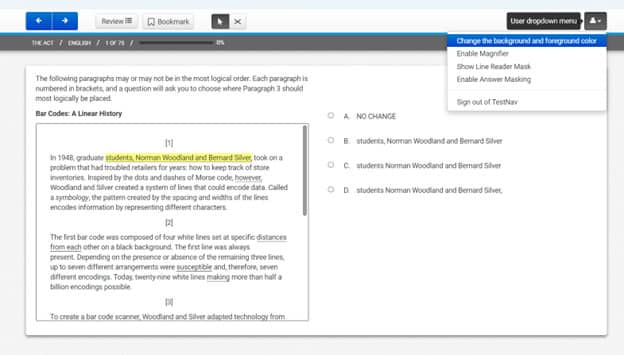Last Updated On: February 25th, 2025
While the SAT has already gone fully digital, the ACT is in the middle of its transition to digital testing. Starting this April (2025), test takers in the United States can choose to take the ACT on the computer or on paper. Both tests must be taken at a school or test center using the facility’s computer, so testing from home is not an option.
The switch to digital testing gives the potential for more flexibility and a larger choice of test dates, but right now the digital test seems to have more limited locations. When I set up a profile and clicked to register in Los Angeles, for example, the registration website offered several options within five or ten miles of my house for the February, April, and June paper tests, but the nearest digital test site was 69 miles away in April, and 17 miles away in June. (It’s only on paper in February.) I imagine that options are more limited outside of big cities. While digital testing is currently the only option for international students, it does not seem to be widely available in the US. If you have a strong preference for the digital test, however, it will be available starting in April in some locations.
The switch to digital testing also comes with changes to the test’s length and format that will take effect April 2025. Today, when you download and practice with TestNav, the ACT’s digital online platform, you will find the current test’s format and length, which match the paper test. If you are taking the test in February 2025, this is your test format. If you are taking the test in April 2025 or later, however, the digital ACT should reflect the new test format and length. If you want to try the new, digital test, you can find it on the ACT’s website under “sample questions.”
There are a few differences between the old, paper ACT and the new, digital ACT. One big difference is that the Science section is optional. If you opt to take the digital ACT in April, you can click a button to take it without the Science section, while students who sign up for the paper test must take the Science section. Both paper and digital test-takers can choose whether to take the Writing (AKA Essay) section. Another difference between the current ACT and the digital ACT is that the digital test is slightly shorter, and each question in the math section now has four possible answer choices instead of five. The good news is that if you prepared for the old ACT, you’ll already be prepared for the updated digital ACT. Based on published sample questions, the overall format and types of questions and passages appears to be about the same. The test does not adapt by section like the Digital SAT, and there are nine questions per passage on the Reading section. The number of questions and possibly the length of passages will be different with the digital ACT until September 2025, when the paper test will also reflect the updated test format.
Here are the differences according to the ACT’s website:
| Section | Old Test Questions and Time | New Test Questions and Time |
|---|---|---|
| English | 75 questions; 45 minutes | 50 questions; 35 minutes |
| Math | 60 questions; 60 minutes | 45 questions; 50 minutes |
| Reading | 40 questions; 35 minutes | 36 questions; 40 minutes |
| Science | 40 questions, 35 minutes (not optional) | 40 questions; 40 minutes (optional) |
| Writing (Optional) | 1 question; 40 minutes | 1 question; 40 minutes |
If the shorter version of the test appeals to you and you want to take the test this spring, it may be worth a long drive to find a computer test center. And if you choose to take the digital test, it is worth downloading TestNav, the ACT’s digital platform, to practice with the program. When I tried it, I wasn’t able to get in with a username and password, which seems to be an option only for students taking the actual test (as far as I can tell). I clicked on “Practice Tests” below the sign-in boxes and got the current version of the test. In order to try the new, shorter version of the test, you’ll have to go to the ACT’s website. Since this is a time of transition for the ACT, I suspect that the practice test experience will be the same for the website and TestNav soon. For both options, while I got a report of my correct, incorrect, and skipped questions at the end of each section, I did not receive a score report with a score out of 36, and my data wasn’t saved. As of now, it seems like the SAT has more resources for practicing the digital test in a format where one’s work can be saved, analyzed, and reviewed later.
What is the experience of the digital test?
If you have experience with digital tests, TestNav’s platform will probably seem similar to that of other tests you’ve taken. There is a tutorial for the platform that is definitely worth going through before the test. Each test section opens with directions, which are similar to the paper test but adapted for the on-screen version. There is a countdown timer in the top righthand corner, a review screen where students can view which questions they’ve done so far, a “bookmark” button to mark questions for later review, and arrows to click to the next question. Questions appear on the right-hand side of the screen, while text and problems appear on the left side. Test-takers may highlight text with a few different color choices, cross off answer choices with an answer eliminator tool, magnify select text, change the background and foreground color, block out all but a few lines with the “line reader mask” tool, mask and unmask the answer choices, and play text to speech. On the math test, students may click on the calculator icon to pull up a Desmos graphing calculator at any time. If you’re planning to take the digital test in April or later, you will find it useful to practice with the online platform, but you should be aware that TestNav has not yet been updated for the changes coming to the digital test, so you’ll have to use the website practice test for that.

The digital ACT offers a promising development for a shorter and less stressful test experience, especially if you’re skipping the science section. For students taking the test in the 2025-26 academic year or later, the ACT will likely release digital practice materials that match the test and have more digital test centers available for students. If you’re taking the test this spring, however, the convenience of a close location and readily available practice materials in the format of the test may push you to stick with the paper ACT.



















